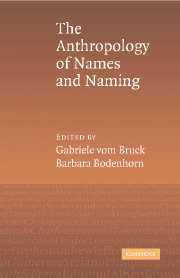Book contents
- Frontmatter
- Contents
- Contributors
- Preface and Acknowledgments
- 1 “Entangled in Histories”: An Introduction to the Anthropology of Names and Naming
- 2 “Your Child Deserves a Name”: Possessive Individualism and the Politics of Memory in Pregnancy Loss
- 3 Why the Dead Do Not Bear Names: The Orokaiva Name System
- 4 The Substance of Northwest Amazonian Names
- 5 Teknonymy and the Evocation of the “Social” Among the Zafimaniry of Madagascar
- 6 What's in a Name? Name Bestowal and the Identity of Spirits in Mayotte and Northwest Madagascar
- 7 Calling into Being: Naming and Speaking Names on Alaska's North Slope
- 8 On Being Named and Not Named: Authority, Persons, and Their Names in Mongolia
- 9 Injurious Names: Naming, Disavowal, and Recuperation in Contexts of Slavery and Emancipation
- 10 Where Names Fall Short: Names as Performances in Contemporary Urban South Africa
- 11 Names as Bodily Signs
- Bibliography
- Index
7 - Calling into Being: Naming and Speaking Names on Alaska's North Slope
Published online by Cambridge University Press: 17 August 2009
- Frontmatter
- Contents
- Contributors
- Preface and Acknowledgments
- 1 “Entangled in Histories”: An Introduction to the Anthropology of Names and Naming
- 2 “Your Child Deserves a Name”: Possessive Individualism and the Politics of Memory in Pregnancy Loss
- 3 Why the Dead Do Not Bear Names: The Orokaiva Name System
- 4 The Substance of Northwest Amazonian Names
- 5 Teknonymy and the Evocation of the “Social” Among the Zafimaniry of Madagascar
- 6 What's in a Name? Name Bestowal and the Identity of Spirits in Mayotte and Northwest Madagascar
- 7 Calling into Being: Naming and Speaking Names on Alaska's North Slope
- 8 On Being Named and Not Named: Authority, Persons, and Their Names in Mongolia
- 9 Injurious Names: Naming, Disavowal, and Recuperation in Contexts of Slavery and Emancipation
- 10 Where Names Fall Short: Names as Performances in Contemporary Urban South Africa
- 11 Names as Bodily Signs
- Bibliography
- Index
Summary
My name is Tsoai-talee. I am, therefore, Tsoai-talee; therefore I am. The storyteller Pohd-lohk gave me the name Tsoai-talee. He believed that a man's life proceeds from his name, in the way a river proceeds from its source.
(N. Scott Momaday 1976)English, I suspect, leads us down some linguistic garden paths when used to discuss name categories. In Iñupiaq, for instance, one can only ask kiña atiñ? Who is your name? Although one may ask, “suna una?” (what is that?) in reference to things, “suna atiñ?” (what is your name?) is a non-question. The response, “uvaanga Qimmieluk,” translates literally as “I, Qimmieluk.”
The question “Who is your name?” and the answer, “I, Qimmieluk,” offer us a framework – on which I shall build over the next pages – that allows us to examine several notions. The first is that the power of recognition and the power of speech are crucial aspects of naming. On the North Slope, both recognition and speaking personal names are instituted positively; in other contexts the potential dangerous power of both may be marked through avoidance. Lest we be tempted to interpret this purely in discursive terms, this chapter explores the extent to which the power of both speech and recognition are linked in important respects to the who of the name itself. The who of the name, I then suggest, not only implies identity but also sociality that may potentially exist well beyond the immediate universe of the name holder.
Information
- Type
- Chapter
- Information
- An Anthropology of Names and Naming , pp. 139 - 156Publisher: Cambridge University PressPrint publication year: 2006
